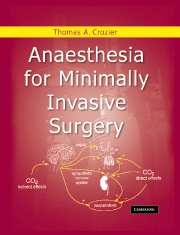Book contents
- Frontmatter
- Contents
- Preface
- Foreword
- Acknowledgements
- 1 Introduction
- 2 Physiology
- 3 Preparing and positioning for laparoscopic surgery
- 4 Monitoring
- 5 Anaesthesia for laparoscopic surgery
- 6 Complications and contraindications of laparoscopic surgery
- 7 Post-laparoscopy pain and pain relief
- 8 Laparoscopic bariatric surgery
- 9 Minimally invasive thoracic surgery
- 10 Laser surgery of the upper aerodigestive tract
- 11 Minimally invasive neurosurgery
- Index
9 - Minimally invasive thoracic surgery
Published online by Cambridge University Press: 21 October 2009
- Frontmatter
- Contents
- Preface
- Foreword
- Acknowledgements
- 1 Introduction
- 2 Physiology
- 3 Preparing and positioning for laparoscopic surgery
- 4 Monitoring
- 5 Anaesthesia for laparoscopic surgery
- 6 Complications and contraindications of laparoscopic surgery
- 7 Post-laparoscopy pain and pain relief
- 8 Laparoscopic bariatric surgery
- 9 Minimally invasive thoracic surgery
- 10 Laser surgery of the upper aerodigestive tract
- 11 Minimally invasive neurosurgery
- Index
Summary
Minimally invasive endoscopic surgery of thoracic organs can be performed by bronchoscopy, mediastinoscopy or thoracoscopy and usually involves the lungs, the pericardium, the oesophagus, the thymus, the thoracic part of the sympathetic nervous system and occasionally the thoracic spine. The following, non-inclusive list gives an idea of the scope of present indications for endoscopic thoracic surgery (Table 9.1).
Bronchoscopy
Bronchoscopy is possibly the oldest endoscopic procedure used in the diagnosis and treatment of intrathoracic disease processes. In 1897, Gustav Killian used a Mikulicz-Rosenheim oesophagoscope to extract a bone lodged in the right main bronchus of a 63-year-old man. Chevalier Jackson and Victor Negus were instrumental in the introduction of the technique in the US and the UK. Innovations in fibre-optics led to the development of a flexible bronchoscope and its introduction into clinical practice by Shijeto Ikeda in 1968. The rise of the field of interventional pneumonology is directly related to improvements of bronchoscopic instruments. There is considerable overlap of the departments of otorhinolaryngology and interventional pneumonology in the treatment of airway tumours (see Chapter 10).
The modern rigid bronchoscope is a metal tube, available in various sizes, with a bevelled, slightly flared distal end, and a proximal end with a side-arm for attaching the anaesthetic breathing system (Figure 9.1). The open proximal end can be occluded with an eyepiece or a port, which allows the introduction of the rod telescope and permits simultaneous bronchoscopy and ventilation.
- Type
- Chapter
- Information
- Anaesthesia for Minimally Invasive Surgery , pp. 121 - 144Publisher: Cambridge University PressPrint publication year: 2004



